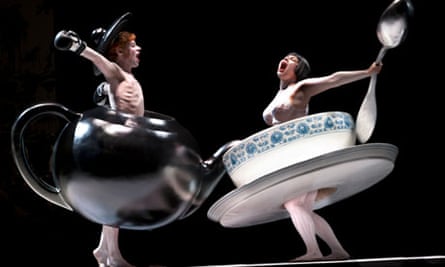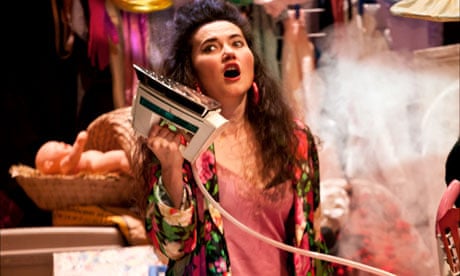'I turned 50 this year," says French opera director Laurent Pelly, "and this is like the best birthday present!" From the airy environs of Glyndebourne's restaurant, where we meet for lunch, it's certainly easy to picture the pastoral surroundings, well-kept gardens and gourmet food as the icing on the cake of the company's enviable production facilities. But for Pelly, that's not the real treat. What delights him most – what makes his eyes alternately sparkle and mist over – is the work he has been commissioned to stage: Maurice Ravel's 1925 opera L'Enfant et les Sortilèges.
"It's a story about a child that is fantastical and funny and scary and touching all at the same time," he says. "I first heard it when I was eight years old, and I've adored it ever since." So when Glyndebourne director David Pickard approached him for a follow-up to his much-praised 2008 production of Humperdinck's Hänsel und Gretel, Pelly was unequivocal: he wanted to do L'Enfant.
It is actually a lot to ask. The opera may be only 45 minutes long, but it zips through more than 20 scenes, and along the way it calls for a versatile cast playing double roles, a large orchestra to realise the picturesque effects and profusion of musical styles, a chorus of adults and children, and assiduous attention to set and costumes in order to portray objects that spring to life – a clock, chairs, a teapot, a book of arithmetic – as well as singing trees, cats, frogs and dragonflies. "And still, everything has to be light and flow smoothly," says Pelly, his voice almost betraying the weight of work he's landed himself in. "It all takes as much care and consideration as a four-hour opera."
To make the proposal more workable, Pelly suggested that they pair L'Enfant with an existing work, and put forward his own 2004 Paris Opera production of Ravel's other opera, L'Heure Espagnole (1911), which with only five singers and a single set would be easier to manage.
It is the differences between the operas as well as the rarity of the pairing that makes this programme such a treat: if L'Enfant is about childhood, L'Heure is about adults. Adultery, in fact. "The whole piece is about a woman who wants to have sex," Pelly says. "It's a comedy, like French vaudeville from the early 20th century – a little dirty, a little naughty. It is set in Spain, but really it is totally French, full of parodies, cliches and innuendo. Based on a farce by Franc-Nohain, L'Heure espagnole tells the story of a clock-maker's wife whose assignation with her lover during the one hour a week her husband is away is thwarted, first by a mule-driver needing his watch mended, then by a banker who fancies his chances with her. Juggling their demands with her desires, she has the suitors hide inside grandfather clocks which the unwitting mule-driver carries up and downstairs for her – until she suddenly realises that if he can heave such loads around, he must have great biceps. She asks him to go upstairs once more – this time, without a clock…

"L'Enfant is such a contrast. The story is sung in verse, and is full of childlike fantasy and sincere feeling. The only thing it shares with L'Heure is Ravel, who is so precise it's as if the stage directions are written in the music." The libretto, by Colette, tells of a boy who, told off by his mother for being naughty, flies into a tantrum and trashes his room. One by one the objects in the room come to life, scolding and scaring him – just as the animals and plants do when he goes into the garden. The boy feels afraid and alone, but a simple act of kindness (he binds a squirrel's paw) makes the animals see that he is, really, a good boy; and they call out for his mother.
"I picture L'Enfant as the boy's nightmare, with the objects and animals like adults," says Pelly. "And my job is somehow to make that dream work on stage."
When we meet, his job is at a crucial juncture. Rehearsals have moved from the studio into the theatre. There are only two weeks until opening night. He has to return to rehearsal and heads off eagerly but anxiously, leaving me with his regular set designer Barbara de Limburg, who fills me in on how L'Enfant is shaping up: "It's an unusual production because the costumes" – as usual, designed by Pelly himself – "are almost the same thing as the decor. When the chair is wheeled on, the singer appears from inside it, in the same pattern as the upholstery. And the garden is really just made from the tree costumes worn by the chorus. Instead of a set, we have a bare stage so that the objects and creatures appear on it like apparitions."
For the look of the piece they took inspiration from surrealist painting. It sounds marvellous, but the team are far too jumpy to let me watch the rehearsal. Instead, props manager Paul Brown gives me a quick but eye-opening tour backstage. The sets for L'Heure (by Caroline Ginet) are only half unpacked, but already cram the props room with all manner of stuff and nonsense: tourist knick-knacks, Catholic kitsch, a bull's head with knickers hanging from one horn, pouty pictures torn from magazines, a wall plastered with clocks.
We move on to the L'Enfant workshop, where model trees (five different species) are being meticulously constructed, each sprouting from a shaft that will fit down a singer's back, to be held in place by harnesses designed for scuba divers and strapped on with orthopaedic braces.
Ravel would surely have loved seeing such backstage workings, for he was captivated by effects and mechanics – as heard in both operas. Yet he could also tap deep, if often submerged, currents of emotion. You find it in the uncannily dark opening to L'Heure, a restless tide of brooding chords that swells and subsides beneath a bank of indifferently ticking metronomes.
Pelly and De Limburg have clearly been enjoying themselves with the production, but, says De Limburg, "at the end of the opera we always cry". And no wonder: the whole trajectory of L'Enfant seems to be condensed into its brief, understated ending: two notes, one word. When I asked Pelly how he would stage this small, sublime moment of pathos, he simply breathed in and said: "I don't know."




Comments (…)
Sign in or create your Guardian account to join the discussion